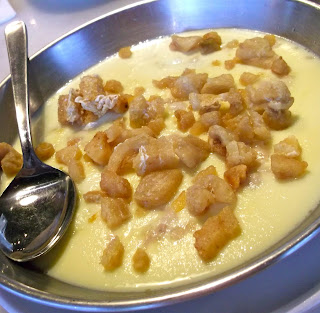I love claypot chicken rice. The multi-layers of satisfaction that a good one brings to me are hard to describe…but I’ll try.
 |
| Details matter and even the accompanying soy sauce is sourced from Kwong Woh Hing, regarded as the best manufacturer in Sg |
You open the lid, and the aroma hits you first: the smell of burnt rice, of dried sausages, and salted fish. The pot of rice, topped with moist glistening meat, greets your eyes. Then come the mouthfuls of flavor: the sweetness of dark sauce and lard, the succulence of chicken, and – for me and others like me – the brittle hardness of the golden bottom ‘crust’. When it comes to claypot rice, you eat with nose and eyes, as much as mouth. We Singaporeans have a word for it – ‘shiok’ (utter satisfaction)
So, when I moved to Hong Kong and encountered claypot rice (which in Hong Kong is only eaten in winter), it was a pretty big shock. Why wasn’t the rice properly burnt? And, where was the dark soy sauce? I came to miss the Singapore ‘version’ tremendously. But…it was better than nothing.
 |
| This dish allows one to appreciate the true flavours of rice, chicken oil and ginger. |
Gradually, like a novice learning the art of meditation, my perspective changed, and I began to appreciate the elegant simplicity of the Hong Kong version. I focused on the rice itself, and saw how the accompanying ingredients drew the best out of the simple grain.
In cooler climates, where food does not go bad that easily, people are more used to the freshness of meat and the crispness of herbs and vegetables. Their taste buds, it seems, are more acute to tastes and textures. We, in the hot tropics, on the other hand, are used to food that is more heavily spiced, seasoned, or cured that came as a result of earlier times when refrigeration was non-existent, and food that was less than fresh needed to be masked.
When we in Singapore eat claypot rice, we use the dark sweet sauce with a vengeance. While this gives an exceptionally robust aroma to the dish, it drowns out all its other flavors. In Hong Kong, I came to realize that their lighter cooking style actually brought to the fore other qualities of claypot rice that I used to overlook, such as the taste and texture of the rice grains, the seasonings of the main meat, the quality of the preserved/waxed meats, and the fragrance of the light soy sauce.
In Singapore, I came closest to this eating experience at Claypot Fun, a restaurant at East Coast Parkway. They do claypot rice in Hong Kong style; the owner having taken considerable pains to adapt, master and transport the spirit and taste of this version of claypot rice to Singapore. No dark sweet sauce is added or even offered on the table, and the rice isn’t burned to the carbon-like extent we’re used to.
 |
| Cheong fun and fried cruller - odd but it is a marriage made in heaven |
The flavors of this style of claypot are less explosive, less immediate; but each mouthful brings mounting discovery as the distinct and innate tastes and smells of rice, chicken, sausage, and soy sauce become more and more apparent, and mingle in your mouth. To heighten enjoyment, add some chicken oil (a special optional condiment) into the steaming claypot, because -- as any gourmet will tell you -- when it comes stirring up full-bodied flavor nothing beats a touch of animal oil.
 |
| Deceptively simple but getting the right texture of porridge takes skill and a play of grains |
I loved the porridge here as well. Two different types of rice go into it: one to give the porridge its smooth gooey texture, and the other to produce the so-called ‘rice breath’. The Chinese have always been fastidious about rice. In the restaurants of old Canton, it was common to specially hire a chef for the sole purpose of cooking rice and porridge, and this expert would normally be the highest paid man in the kitchen. Modern Chinese kitchens may not go so far, but some come awfully close. Claypot Fun grinds the rice for its ‘cheong fun’ skin daily to ensure optimum freshness, and the gorgeously silky melt-in-your-mouth result clearly repays the effort.
Other dishes worth looking out for:
 |
| A comfort food with a twist: steamed egg custard with pork crispies |
 |
| Loaded with cholesterol but packed with taste: Claypot Pork Liver |
The Dance of the Stoves
Growing up, this was how I remembered that claypot rice would be prepared on the streets. The rice would be washed, drained and kept until it was ready for cooking. This allowed the rice to absorb water, resulting in fluffier grains when cooked. Next, a bit of salt was added to the rice to enhance flavour, and oil to add glisten to its appearance. The rice was then cooked at different temperatures at various stages. Turning the pot on the stove ensured the crust was evenly formed. In the past, it was common for the chef to have 20 or more charcoal stoves lined in front of him. The stoves would be operating at different flames and temperatures, and the chef would rotate the pots among them, like a game of musical chairs.
Note: Claypot Fun also serves dim sum from morning till 3 pm.
Claypot Fun
Playground @ Big Splash
Blk B, 902 East Coast Parkway
#01-11 East Coast Park
Singapore
Telephone: 65-6440 7975

No comments:
Post a Comment